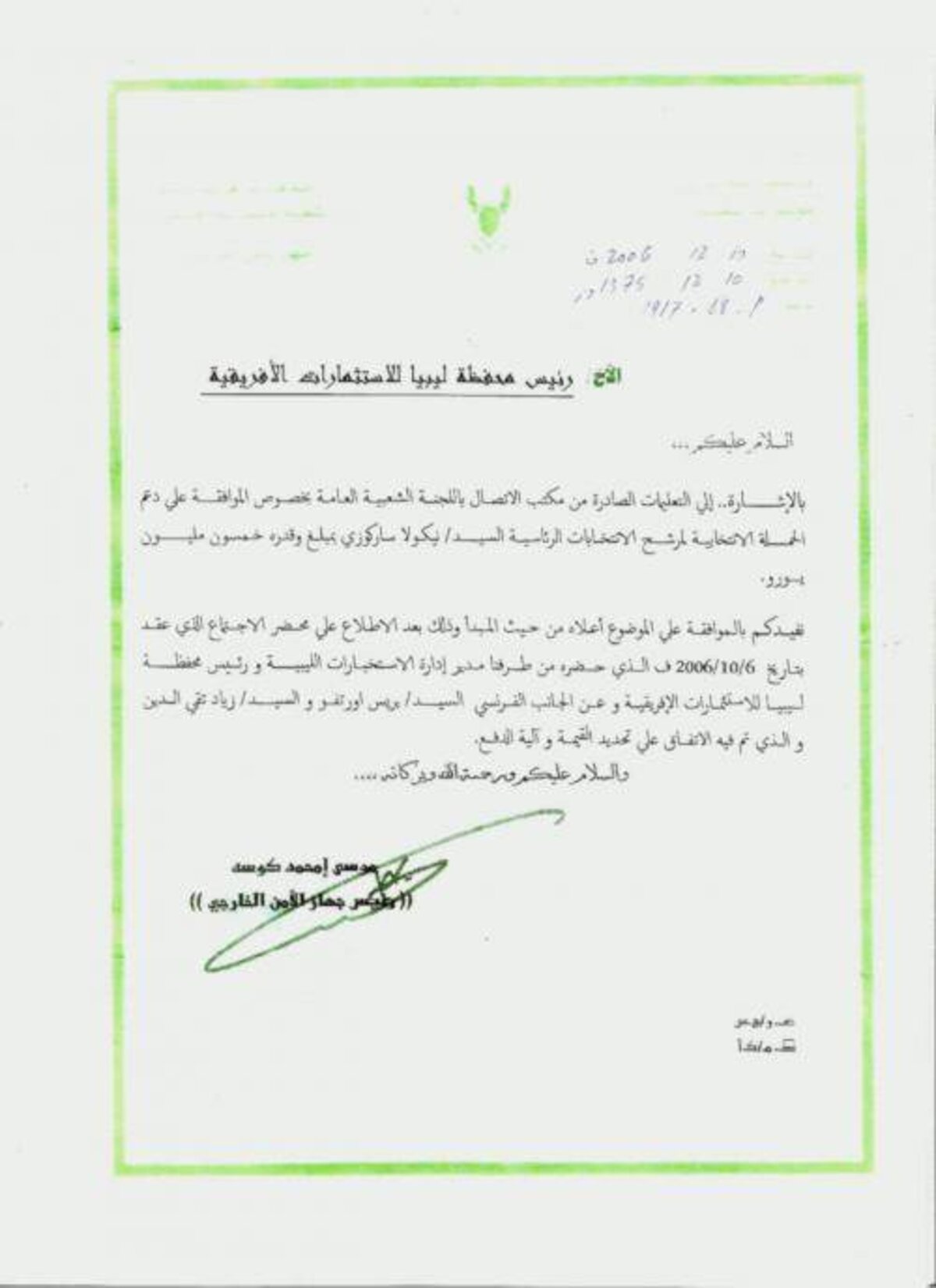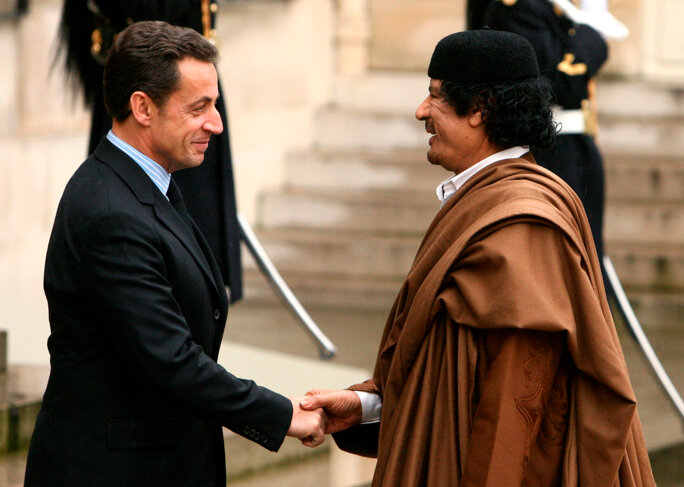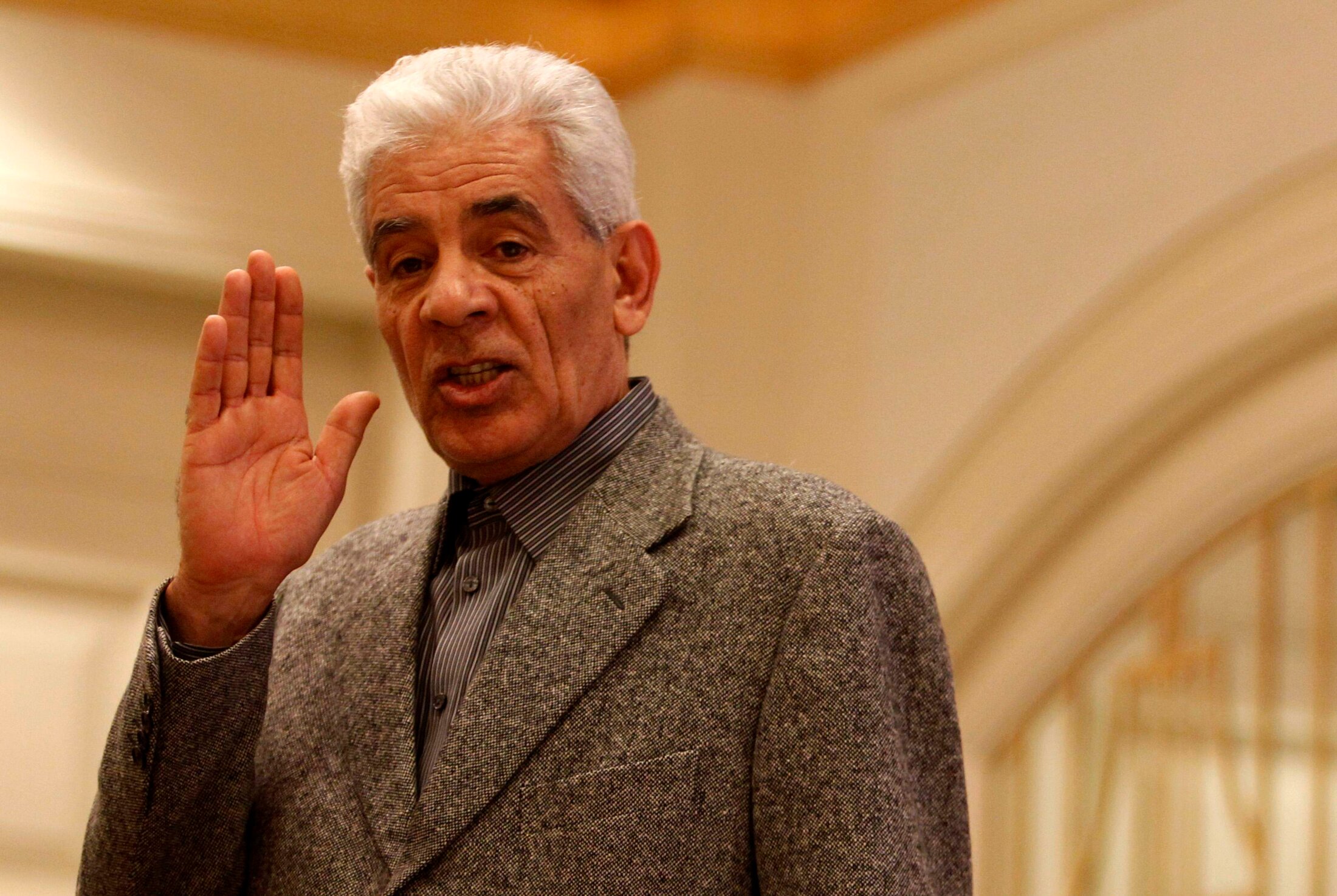In April 2012, Mediapart revealed the existence of an official Libyan document which detailed how the regime of late Libyan dictator Muammar Gaddafi had approved the payment of 50 million euros for the secret funding of Nicolas Sarkozy's 2007 presidential election campaign.
The letter, dated December 10th 2006, is signed by Moussa Koussa, the then-head of Libya's foreign intelligence agency, and is addressed to Gaddafi's chief-of-staff, Bashir Saleh, president of the Libyan African Portfolio (LAP), one of the main investment arms of the regime, and who was in charge of supervising the payments.
The publication of the document followed a lengthy series of investigations by Mediapart into the dealings with the Gaddafi regime by Sarkozy and his close entourage during preparations for the latter’s bid for the French presidency.
The letter said that the regime had agreed to support “the electoral campaign of the candidate Monsieur Nicolas Sarkozy for the presidential elections, to the sum of fifty million euros”. The letter also stated that an agreement on “the amount and method of payment” had been reached at a meeting two months earlier involving Brice Hortefeux, a longstanding close personal and political ally of Sarkozy’s.

Enlargement : Illustration 1

Two days after the publication of the document, Sarkozy dismissed the document as being “a crude forgery” and lodged a complaint against Mediapart for ‘forgery and use of forgery’, which a subsequent police investigation found no grounds to pursue.
After that case was thrown out, Sarkozy then lodged a lawsuit as a civil party against Mediapart, again for ‘forgery and use of forgery’ which, under French law, automatically triggered a judicial investigation to establish the authenticity of the document.
The magistrates in charge of the investigation, judges René Cros and Emmanuelle Legrand, appointed French IT engineer Roger Cozien for his expert appreciation of the authenticity of the document.
In 2009, Cozien developed, initially for the French Ministry of Defence, a software tool that could detect the alteration of digital images and their falsification. Called Tungstene, it has subsequently been employed by a number of institutions, and also the French justice system. Tungstene has been regularly upgraded, and was used here in its latest “6.6” version.
Cozien claims that the software leaves a “minimal, even inexistent” margin of error. His conclusions about the Libyan document published in April 2012 by Mediapart were submitted to judges Cros and Legrand in a 60-page report on November 6th.

Enlargement : Illustration 2

His brief included establishing whether the photo of the document published by Mediapart was altered or even completely falsified, whether it was indeed a true reproduction of a real paper document, and whether that original paper document had been falsified. His findings, cited below, were emphatic:
“After multiple calculations and the use of all relevant filters from the Tungstene software, no trace of alteration, and even less of voluntary falsification, were detected,” reads his report. “We pushed the mathematics we have to the limit of their possibilities. Everything leads one to conclude that the digital image contained in the source file (the subject of our expert analysis) was initially the result of a digitizing process of a physical document, probably of paper matter.”
Cozien continues: “We have been able to determine that the document, which was apparently digitized, presents classic and symptomatic physical characteristics of such a physical object, presenting a certain degree of wornness, even ageing. We were able to determine that different inks were probably used, at different times during the life of the physical document. The total of these results argues very strongly in favour of a physical document that had really existed and which would have been digitized in order to produce a primary digital image.”
He concludes: “The very great coherence between the examination and the visual and semiotic intuition on the one hand, and the results of the multi-spectral analysis on the other, leads us to favour the option of an authentic document that existed on a physical support.”
Tungstene was recently adapted to be able to study the authenticity of physical documents – that is, documents that are made of paper or other physical matter – by examining only their reproduction on digital images. Roger Cozien concluded not only that the document presented by Mediapart had existed as a physical document, but also that the physical document showed signs of being worn with time - as indeed one would expect of such a piece of paper dating from 2006. The observation that several different types of ink were present on the document is also coherent, given the signature that lies at the bottom and the presence of rubber stamping.
In short, Cozien’s expert analysis concludes that: the photo of the document published by Mediapart was not a digital creation and the image had not been tampered with; that the original paper document had existed; that the paper document was of “extreme coherence” and therefore excluded to a very high degree of certainty any falsification (such as overprinting, additions to the text or deliberate erasures).
Key witness smuggled out of France
While the report finds that the original document could in theory have been a manipulation, it states that this in practice is improbable because in such a case those who created it would have had to have been aware some years ago – given the paper had aged with time - of how to fool the current technical capacity of Tungstene to analyse it.
Cozien’s report is not the first expert analysis to find in favour of the authenticity of the document. In 2014, graphologists Jean-Louis Lebrave and Claude Toffart were commissioned by judges Cros and Legrand to deliver their appreciation of the authenticity of the writing and signature on the letter (which was compared to other documents also signed by Moussa Koussa). To help in their analysis, they called upon the services of Arabic translator, Sylvana Kattar Monseur, a recognised expert on different aspects of the language who, their report reads, “validated elements concerning writing in the Arabic alphabet”. In their report delivered to the judges in November 2014, all three experts concluded that the signature on the December 2006 letter published by Mediapart was made “by the hand” of Moussa Koussa himself.

Enlargement : Illustration 3

Koussa was questioned by the French magistrates in August 2014 in the Qatari capital Dohar, where has lived in exile since the fall of the Gaddafi regime in 2011. In a transcript of the questioning on August 5th 2014, Koussa was asked to explain what he meant when he said the contents of the letter published by Mediaprt were not false. “Its origins, its contents, that’s what,” he answered. “The contents of this document, that’s what is dangerous. It’s for you to know if it’s true or false. I didn’t tell you whether it was false or not. There is what is mentioned in this document and someone who has put a false signature underneath, for you to investigate.” However, three months later the graphologists’ report unanimously concluded the signature was that of Koussa.
The 2006 letter was addressed to Bashir Saleh, Gaddafi's chief of staff and president of the Libyan African Portfolio (LAP), one of the main investment arms of the regime. Saleh was living secretly in exile in France to where he had been smuggled from Libya after the fall of the regime. On May 3rd 2012, five days after Mediapart first revealed the existence of the Libyan document, Saleh fled from France to his native Niger, and has since settled in South Africa.

Until then, Saleh had been living in France under official protection, despite the fact that since March that year he was the subject of a ‘red notice’ issued by Interpol for his arrest pending an eventual extradition back to Libya where he was wanted by the country’s new authorities on charges of fraud, misappropriation of public funds and abuse of power.
A separate judicial investigation into evidence that Sarkozy’s 2007 election campaign received secret funding from the Gaddafi regime, launched in April 2013 and led by judge Serge Tournaire, has since established that Saleh’s flight from France in May 2012 was organised by the French domestic intelligence agency, then headed by Bernard Squarcini, a figure close to Sarkozy, in coordination with the interior ministry. At the time, the interior minister was Claude Guéant, Sarkozy’s longstanding chief of staff who was his 2007 election campaign director and who played a key role in Sarkozy’s dealings with the Gaddafi regime in 2006.
Guéant has been placed under investigation – a legal status one step short of being charged - by Judge Tournaire over a payment of 500,000 euros he received in 2008. Guéant is suspected of having received the payment from Libyan funds managed by Saleh, despite his claims that they came from his sale to a Malaysian lawyer of two paintings by 17th-century Dutch artist Andries Van Eertvelt. However, it soon emerged that the sum would have been well in excess of the market price for the Dutch artist’s works, and that Guéant had never applied for the legally-required export certificate for such a sale.
Meanwhile, in a separate case, Guéant appeared before court last month charged with “embezzling public funds” when, between 2002 and 2004, he was chief of staff to then-interior minister Nicolas Sarkozy. Guéant and four senior public officials, including former police chief Michel Gaudin, stood accused of organised theft from interior ministry cash funds destined to pay for police investigations and surveillance operations. Guéant, who pocketed a total of 210,000 euros for his personal benefit, free of tax, never denied taking cash from the fund but claimed it was part of a traditional, longstanding bonus system.
The trial magistrates announced their verdict on Friday November 13th, when Guéant was found guilty as charged and was handed a suspended two-year jail term, a five-year ban from holding public office, and a fine of 75,000 euros. Gaudin was given a ten-month suspended prison term, while the three other officials - Michel Camux, Daniel Canepa and Gérard Moisselin – were given eight-month suspended jail terms and fines ranging from 20,000 euros to 40,000 euros. Guéant announced on Friday that he will appeal the sentence.
-------------------------
- The French version of this article can be found here.
English version by Graham Tearse


